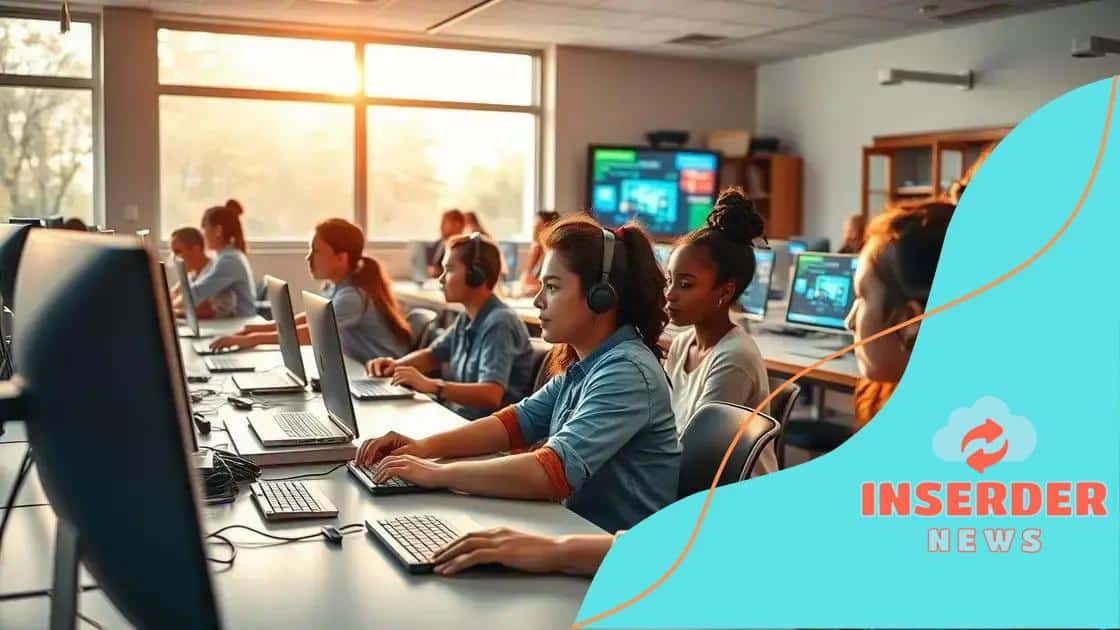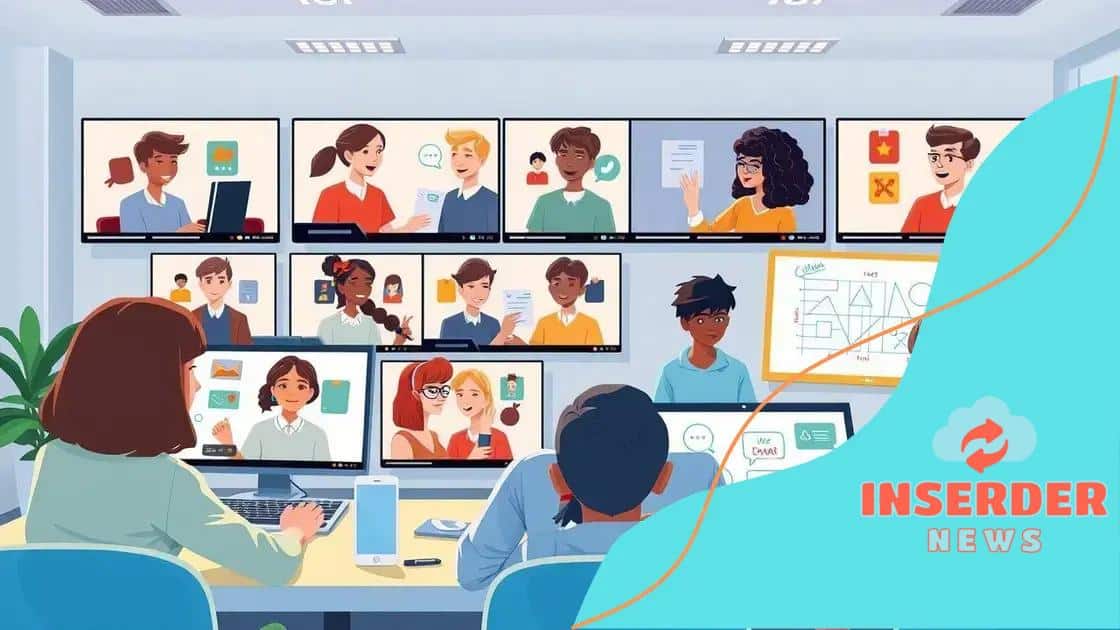The future of distance learning in universities

The future of distance learning in universities consists of enhanced engagement, advanced technologies, and a focus on personalized education, ensuring that students receive high-quality instruction and support in a flexible learning environment.
The future of distance learning in universities is an exciting frontier where technology meets education. Ever wondered how online platforms can enhance your learning experience? Let’s dive into this evolving landscape.
Understanding distance learning evolution
Understanding the evolution of distance learning is essential for appreciating its current state. Over the years, the methods of teaching and learning have drastically changed, fueled by advancements in technology.
The roots of distance learning can be traced back to the early days of correspondence courses. These courses allowed students to learn from home via mail. As technology progressed, so did the methods used for distance education. From radio and television courses to the internet, each evolution has opened new doors for learners.
Technological Milestones in Distance Learning
Several key technologies have shaped the landscape of distance learning:
- Internet Access: The widespread availability of the internet has made online learning feasible for many.
- Learning Management Systems (LMS): Platforms like Moodle and Blackboard have transformed course delivery.
- Multimedia Resources: Videos, podcasts, and interactive content enhance the learning journey.
In today’s world, distance learning is more flexible than ever before. Students can now attend courses from anywhere, fitting education into their busy lives. This flexibility is crucial for many learners who balance work and family responsibilities. Gone are the days when students had to commute to a physical classroom.
Impact of Recent Events
Recent global events have further accelerated the adoption of online education. The COVID-19 pandemic forced many institutions to shift to remote learning. This sudden change highlighted the importance of distance learning and showcased its potential benefits. Both educators and students adapted quickly, finding new ways to engage with the material and connect with each other academically.
As distance learning continues to evolve, so do the best practices for effective teaching. Many educators now utilize interactive methods and community-building strategies in online classes. These approaches help to create a sense of belonging, even in a virtual environment. Distance learning is not just about content delivery; it’s about fostering relationships and collaboration among learners.
Looking ahead, it’s crucial for educational institutions to adapt and innovate continually. By understanding the evolution of distance learning, we can better appreciate its capabilities and the opportunities it presents for future generations.
Key technologies shaping the future
Key technologies are crucial in shaping the future of distance learning in universities. These advancements enhance how educators teach and how students engage with their classes.
One significant technology is the Learning Management System (LMS), which allows institutions to organize courses effectively. LMS platforms provide tools for grading, discussions, and assessments, making learning more structured and accessible.
Innovative Tools Driving Education
Various innovative tools are transforming distance learning. Some of these include:
- Video Conferencing: Applications like Zoom and Microsoft Teams facilitate real-time interactions between students and teachers.
- Adaptive Learning Technologies: These systems personalize learning by adjusting content based on student performance.
- Gamification: Incorporating game design elements into courses enhances engagement and motivation.
Additionally, artificial intelligence (AI) is playing a notable role. AI can analyze data from learners to provide personalized feedback and recommendations. This creates a more tailored learning experience, helping students succeed at their own pace.
Furthermore, mobile technology is crucial. As more students use smartphones and tablets, educational content must be optimized for these devices. This shift allows learners to access resources anytime and anywhere, breaking traditional barriers to education.
Data-Driven Insights
Another technological revolution is data analytics. Educators can track student engagement and performance through data analytics tools. This information helps universities improve their courses and better support students’ needs. By understanding students’ behaviors, schools can create more effective teaching strategies.
As technology continues to evolve, the landscape of distance learning will keep changing. Institutions must stay current with these trends to enhance educational experiences. Embracing new tools and methods will be essential for preparing students for the future.
Student engagement in online education

Student engagement in online education is a key factor in ensuring effective learning outcomes. As more learners turn to distance learning, understanding how to keep students actively involved becomes crucial.
Engagement goes beyond attendance; it includes participation, motivation, and interaction with the course material. When students are engaged, they are more likely to retain information and feel connected to their studies. In the online environment, this can be achieved through various strategies.
Effective Strategies for Engagement
Several approaches can enhance student engagement in online education:
- Interactive Content: Utilizing quizzes, polls, and discussion forums keeps students interested and involved in the learning process.
- Regular Feedback: Providing timely feedback encourages students to reflect on their work and motivates them to improve.
- Community Building: Creating opportunities for students to collaborate and interact with each other fosters a sense of belonging.
Additionally, instructors can enhance engagement through their teaching presence. Being visible and responsive in online classes helps to build relationships with students. It encourages them to participate more actively in discussions and activities.
The Role of Technology
Technology plays an essential role in facilitating student engagement. Learning platforms often include features such as video conferencing and chat rooms, which allow for real-time interaction. These tools help replicate the classroom experience, making students feel more connected.
Moreover, incorporating multimedia elements like videos and interactive visuals can make learning more appealing. For instance, using engaging videos for complex topics can enhance understanding and spark interest. When students find the material enjoyable, they are more likely to stay engaged.
Ultimately, keeping students engaged in online education is an ongoing effort. Instructors must continually adapt their methods to meet diverse needs. By using a mix of strategies and technology, they can create an enriching learning experience that keeps students excited about their education.
Challenges and solutions for universities
Challenges faced by universities in the realm of distance learning can significantly impact the quality of education. Various factors contribute to these challenges, making it essential for institutions to find effective solutions.
One major challenge is ensuring technology access for all students. Not every learner has reliable internet or the necessary devices. This digital divide can hinder participation in online courses. To address this, universities can provide resources like loaner laptops and free Wi-Fi hotspots to students in need.
Tackling Student Engagement
Maintaining student engagement is another issue in online education. Without the in-person interaction of traditional classrooms, students can feel isolated and less motivated. Universities can implement interactive tools and activities to foster a sense of community. Examples include
- virtual study groups
- live Q&A sessions
- discussion boards that encourage participation
These strategies can help create a more stimulating learning environment, making students feel heard and connected.
Addressing Quality of Education
Quality assurance is also a critical concern. With rapid changes in course delivery methods, maintaining high academic standards becomes challenging. Universities need to invest in faculty training to ensure educators have the skills needed to teach effectively in an online setting. Continuous professional development opportunities for instructors can lead to enhanced teaching practices.
Feedback mechanisms are important as well. Regularly collecting input from students about their learning experiences can help institutions adjust and improve courses. This feedback loop creates a culture of continuous improvement.
Lastly, universities must ensure that their online infrastructure is robust. Technical disruptions can detract from the learning experience. Investing in reliable platforms and support services for students can alleviate many of these difficulties. By prioritizing technology and preparing for potential issues, institutions can create a smoother online learning experience.
The role of educators in distance learning
The role of educators in distance learning is critical to student success. As online education grows, teachers must adapt their methods to ensure effective teaching.
Educators serve as facilitators, guiding students through the learning process. Their presence in online classes helps create a supportive environment. One important aspect is communication. Regular communication can make students feel connected and valued. Instructors can use emails, discussion boards, and video messages to maintain contact and promote engagement.
Creating Engaging Content
Another key responsibility is developing engaging course content. Educators should design lessons that actively involve students. Utilizing a variety of resources keeps the learning experience dynamic. Some effective strategies include:
- Interactive Activities: Incorporating quizzes, simulations, and group projects to promote participation.
- Multimedia Resources: Using videos, podcasts, and infographics to enhance understanding.
- Real-World Applications: Linking course material to real-life situations helps students see the relevance of what they are learning.
Moreover, educators must foster a sense of community among students. Online learning can feel isolating, so it is essential for instructors to create opportunities for collaboration. Group discussions and peer feedback can promote interaction and encourage teamwork.
Providing Support and Guidance
Instructors also have the role of guiding students through challenges. They should be approachable and offer support when students struggle. Understanding different learning styles and needs allows educators to tailor their approaches. By being flexible, they can help students succeed and reach their goals.
Lastly, continuous professional development is essential for educators. Staying updated on the latest trends and technologies in online education ensures they can provide the best learning experiences. Workshops, webinars, and networking with peers are great ways to enhance their skills.
FAQ – Frequently Asked Questions about Distance Learning in Universities
How can distance learning benefit students?
Distance learning provides flexibility, allowing students to learn at their own pace and schedule, making education more accessible.
What technologies are essential for effective online education?
Key technologies include Learning Management Systems (LMS), video conferencing tools, and interactive content that enhance the learning experience.
How can educators increase student engagement in online classes?
Educators can increase engagement by incorporating interactive activities, fostering communication, and creating a sense of community among students.
What challenges do universities face in distance learning?
Universities face challenges like technology access, maintaining engagement, ensuring quality education, and providing adequate support for students.






